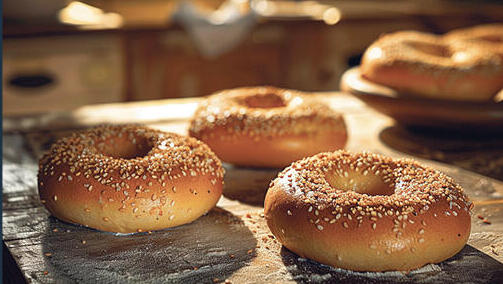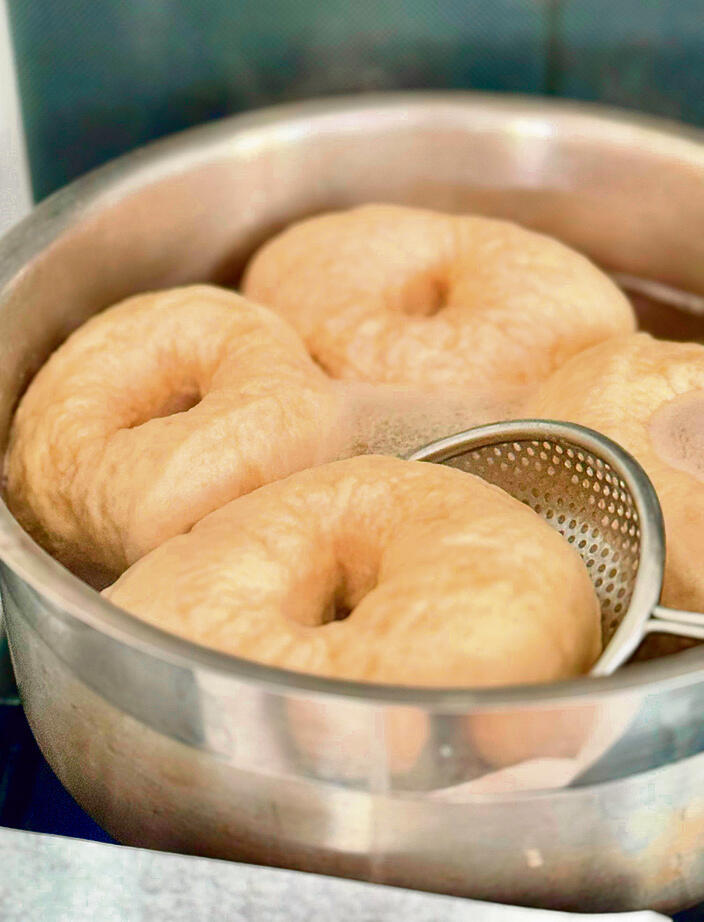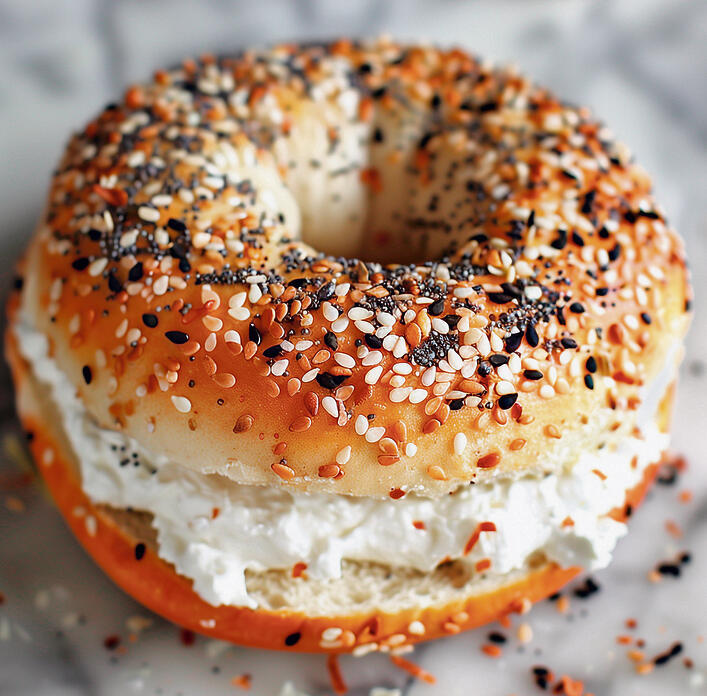It was a cherished tradition at Grandma Esther’s house. We’d land at the vast and unsightly Kennedy Airport at six in the morning, collect our luggage, and make our way to her place after disembarking from El Al Flight 001, looking wild, disheveled, and absolutely famished. Esther’s first move was to pull bagels from the freezer—just the plain ones from the supermarket.
She’d place the halves on a tray and pop them into the toaster. Five minutes later, they’d emerge golden, sweet, crispy, yet soft, dense, and flaky. A layer of cream cheese would melt over them like a soft white blanket. The high priestess of the Turkish-Jewish-American kitchen also had a fondness for efficient inventions like bagels with cream cheese.
Indeed, this is an efficient invention with an amazing story behind it, laden with politics and wars, as usual.
The tale of the American bagel begins like all great stories—with a journey. Harry Lander, a Jew who left his home in Lublin, Poland, in 1927, embarked on a long voyage to America with his family. He arrived in New Haven, Connecticut, with one clear aspiration: to bake the best bagels America had ever seen. While bagels had existed in Poland for centuries, today we're focusing not on the Polish bagel but on Uncle Sam’s bagel.
In the beginning, Harry worked in small bakeries, deftly maneuvering between flour and yeast. Each bagel was crafted with love and memories from home—or whatever cliché you prefer. He managed to build a small but loyal fan base, with his family—his wife Rose and their children—contributing to the creation of perfect bagels.
Meanwhile, another crucial front was developing. In the early 20th century, the first attempts at freezing food began. If we thought this technology had always existed, well, it hadn’t. Initially, fruits were frozen, then vegetables, but slow freezing ruined meat, vegetables, bread, and almost everything else.
Enter Clarence Birdseye, a smart inventor and fishing enthusiast. During his work with the U.S. Department of Agriculture, he traveled to Canada and observed how the Inuits threw fresh fish into the snow, which froze quickly and retained their quality. Inspired by the fish in the snow, Birdseye developed quick-freezing technology and even freezers.
It turns out, and this is always true, that every technology spawns many other technologies to make it feasible. Freeze strawberries? Great. But there’s no point in having lots of frozen strawberries if you can’t transport them (you need refrigerated trucks), display them in supermarkets (display freezers), or store them at home (home freezers). All these technologies gradually developed in the first half of the last century, accompanied by excitement but also some lethargy, until World War II.
During the war, everything changed. The war economy demanded cuts from the entire economy. There were food allocations and coupons; most canned goods were sent to the front to feed the army, and even metals were confiscated for battle purposes. Frozen food suddenly became the most available and convenient solution for preserving and transporting food across America. The government allocated resources for its development and growth, and the numbers soared, along with investments and technological breakthroughs.
And here’s where the two stories intersect. Harry’s local bagel brand flourished but remained local. So, in the 1950s, when frozen food was already widespread and in high demand, Harry leveraged Birdseye’s technology and established the frozen bagel market (the freezing method was kept secret for the first two years!).
This move wasn’t simple. How do you make a frozen bagel feel as fresh as one just baked? The solution came in the form of a genius idea—attributed to Morrie, one of Harry’s sons—to pre-slice the bagel. It may sound simple, but it was a significant change: customers could take a frozen bagel from the freezer, pop it into the toaster, and enjoy it immediately—crispy on the outside and soft on the inside, just like on its first morning. The bagel entered the supermarket and became an almost immediate hit. From a Polish-Jewish delicacy, it became a staple of the American kitchen. Lander’s frozen bagel turned into a multi-million-dollar empire and another story of a successful American dream of persistence, innovation, and war.
Now, let’s bring it back to us, to the State of Israel. In the United States, the bagel is perceived as essentially Jewish food, so why does a package of six bagels cost nearly 40 shekels here? At Costco in the USA, we paid ten dollars for a package of 12—less than a dollar per unit.
So, we could get angry, and we do get really angry. Or we could make our own bagels. And that’s exactly what we’re going to recommend you do. Don’t be afraid. It’s easy and worthwhile, even if you dirty a few dishes along the way. We recommend making a large batch, and like Lander and Grandma Esther, slicing them after baking and freezing them for times of need and desire. Who knows when flour prices will skyrocket.
So how do you make it?
It is shiny and golden on the outside, dense and soft on the inside. It has a unique sweetness but also a rich and developed flavor. You can add various toppings, but in the end, it’s best enjoyed toasted in the morning with a bit of cream cheese.
Don't be afraid of the step involving boiling in water with date honey – this is how you get the special crust of the bagel.
Ingredients:
For the dough:
- 4 cups bread flour
- 1 tablespoon dry yeast
- 1 tablespoon sugar
- 2 teaspoons salt
- 1 1/4 cups lukewarm water
For the boiling stage:
- 8 cups water
- 2 tablespoons date honey or brown sugar
Topping options: sesame seeds, poppy seeds, coarse salt, or any other toppings you like.
Preparation:
- Prepare the dough: In a large bowl, mix the flour, yeast, sugar, and salt. Add the lukewarm water to the bowl and knead the dough by hand or with a mixer using a dough hook for 10 minutes until you get a smooth and elastic dough.
- Cover with plastic wrap or a damp towel and let it rise in a warm place for an hour until the dough doubles in size.
- Divide the dough into 8 equal parts and roll each part into a ball. Using your fingers, create a hole in the center of each ball and widen it slightly to form a bagel shape.
- Place the formed bagels on a baking sheet lined with parchment paper and cover with a damp towel for another 20 minutes of rising.
- Meanwhile, place a large pot with water and silan on the stove and bring to a boil, and preheat the oven to a high temperature (428°F).
- Gently place the bagels into the boiling water, 2-3 at a time, and cook them for 1-2 minutes on each side. Remove with a slotted spoon and place on a baking sheet lined with parchment paper. If desired, sprinkle with toppings.
- Bake for 20-25 minutes or until the bagels are golden and beautiful.
Rules for Making Bagels at Home:
It might sound intimidating, but it’s a satisfying process involving thorough kneading of a manageable dough.
If you want to understand the processes a bit, here are the rules:
- It’s best to work with bread flour or flour with a high protein content. The gluten developed during kneading gives the bagel its unique elastic and dense texture.
- There’s no problem making the dough in a mixer with a dough hook, but it’s truly an opportunity to practice hand kneading. Unlike focaccia dough (which can reach 80% water content and even more), or bread dough (65% water content), this is a dry and manageable dough that will quickly stop sticking to your hands. The idea in kneading: fold the dough into itself and press. This way, you'll get a nice and developed gluten network.
- The boiling in water: although most bagel shops today skip this step and put the dough in a steam oven and then bake, at home we don’t have a steam oven, so we use the traditional method. This boiling gives the bagel its special crust by gelatinizing the outer starches, unlike the crust of regular bread.
- A bit of date honey in the water: the original recipe calls for adding barley malt to the boiling water, a type of natural sweetener that is hard to find in Israel and is also expensive. Adding this dark and thick sweetener gives the bagel an extra-golden layer, a thin coating of sweetness, and also affects its unique texture. We’ll achieve a similar effect with brown sugar or date honey. Bee honey and maple syrup can also be used.
- Make sure the oven is hot enough when you use it – this is usually why baking recipes fail. It’s hard to overstate the importance of this part.
- Let the bagel cool outside for a few minutes even if it’s hard to resist, especially if you intend to slice and freeze it, to retain its moisture inside.
- Why slice the bagel before freezing? Have you ever tried slicing a frozen bagel? That’s why.




